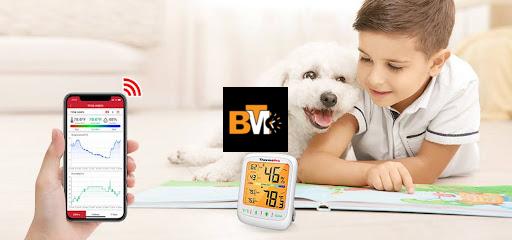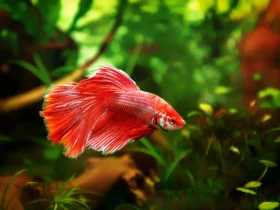As a pet owner, ensuring your furry, feathered, or scaly friend is comfortable at home is a top priority. But did you know that indoor temperature and humidity levels play a crucial role in your pet’s health and overall well-being? Whether you have a cat, dog, bird, reptile, or small mammal, maintaining the right indoor environment can make a significant difference in their comfort and longevity.
In this guide, we’ll explore how temperature and humidity affect small pets, provide practical tips on creating an ideal indoor environment, and use an indoor hygrometer thermometer to keep track of your home’s conditions with ease.

Why Indoor Temperature and Humidity Matter for Pets
Pets are sensitive to temperature changes and humidity fluctuations, and prolonged exposure to an unfavorable environment can lead to health problems. Here’s how it can impact different types of pets:
Dogs and Cats: Low humidity levels can cause dry skin, itching, and discomfort. High humidity, on the other hand, can lead to heat stress, especially in breeds with thick fur.
Birds: Birds are highly sensitive to humidity. Low humidity can dry out their skin and feathers, while excessively high humidity can lead to respiratory issues.
Reptiles and Amphibians: Many reptiles, such as snakes, lizards, and turtles, require a specific humidity range to stay hydrated and support healthy skin shedding. Incorrect humidity levels can lead to respiratory infections and dehydration.
Small Mammals (Hamsters, Guinea Pigs, Rabbits): Dry environments can make these small animals uncomfortable and prone to skin irritation.
Fish and Aquatic Pets: While aquariums maintain their own humidity, the surrounding air in the room can affect evaporation rates and tank water conditions.
How to Determine If Your Home Is Too Dry for Your Pet
Wondering if your home is too dry? Here are some signs to watch for:
- Dry Skin and Itching: Pets may scratch excessively or show signs of flaky skin.
- Increased Shedding: Poor indoor humidity may cause your pets to shed more than usual.
- Respiratory Distress: Pets, especially birds and reptiles, may develop breathing difficulties in dry environments.
- Behavioral Changes: Your pets may become lethargic or uncomfortable if they’re not in their ideal living conditions.
To accurately monitor indoor humidity and temperature, a reliable hygrometer thermometer is essential. This is where the ThermoPro TP359 Bluetooth Indoor Hygrometer Thermometer comes in handy.
Why Choose the ThermoPro TP359 Bluetooth Indoor Hygrometer Thermometer?
The ThermoPro TP359 Bluetooth Indoor Hygrometer Thermometer offers everything you need to maintain an optimal indoor environment for your pets. Here’s why it’s a must-have:
Accurate Temperature and Humidity Monitoring:
Equipped with advanced sensors, the ThermoPro TP359 delivers highly accurate readings, helping you track indoor temperature and humidity fluctuations that could affect your pets.
Bluetooth Connectivity with 260-ft Range:
The Bluetooth feature allows you to monitor conditions remotely from your smartphone, making it easy to check on your pets even if you’re in another room.
Backlit LCD Display for Easy Reading:
With a bright backlit display, you can easily view the readings at any time of day or night. This is especially useful for pet owners who need to monitor conditions around the clock.

Versatile for Multiple Spaces:
The ThermoPro TP359 is perfect for use in various settings, including homes, offices, greenhouses, and even pet enclosures. Whether your pet lives in a cage, aquarium, or terrarium, this device ensures their environment stays comfortable.
How to Create the Ideal Indoor Environment for Your Pet
Now that you understand the importance of maintaining the right indoor conditions, here’s how to create a safe and cozy space for your pets:
Maintain Ideal Temperature Ranges
- Dogs and Cats: Aim for a temperature between 68°F and 78°F.
- Birds: Most birds thrive at 65°F to 75°F.
- Reptiles: Temperature requirements vary by species. Use heating lamps and heating pads as needed.
- Small Mammals: Maintain a moderate temperature between 65°F and 75°F.
Monitor and Adjust Humidity Levels
- Optimal Humidity for Pets: Maintain 40-60% humidity for most indoor pets. Reptiles and amphibians may require 50-70% depending on their natural habitat.
- Use a Humidifier: During the colder months, indoor heating can cause dry air. A humidifier helps maintain moisture in the air.
- Ventilate Properly: Ensure that the air circulates well to prevent excess humidity buildup that can lead to mold and bacteria.
Tips to Keep Pets Comfortable During Seasonal Changes
Spring and Summer: Increase ventilation to prevent overheating. Use fans and air conditioning to regulate temperatures.
Fall and Winter: Use space heaters with caution and consider adding a humidifier to prevent dry air.
Monitor Regularly: Check humidity and temperature levels daily to ensure they remain within a safe range.
Final Thoughts: Worry-Free Pet Care
If you’re ready to take your pet’s comfort to the next level, consider investing in the ThermoPro TP359 Bluetooth Indoor Hygrometer Thermometer. With accurate readings, easy-to-use features, and reliable connectivity, it’s the perfect solution for monitoring and maintaining a safe and cozy environment for your pets.
By following these tips, you’ create a cozy, pet-friendly home where your furry, feathery, or scaly companion can thrive.







Leave a Reply